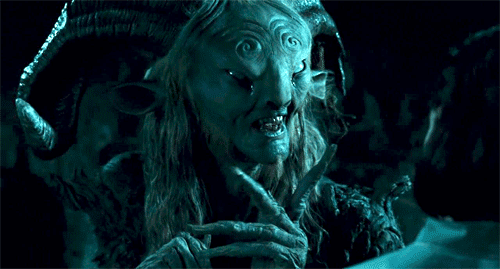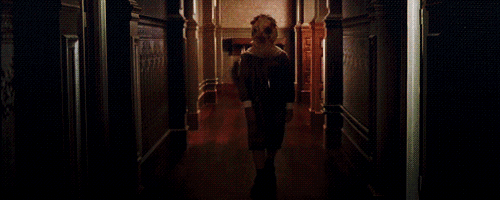Monsters crawl, slither and lurch…
…right?
What about monsters that slink, monsters that scuttle and monsters that creep? Can you tell a monstrous human from a normal human, based solely on the way they move through space?
Let’s expand what we define as “monstrous” to images that are incongruous with their surroundings, visually halting, or out-of-sync. If a character is a monster through movement, they carry themselves in a hybrid of ways that’s unusual to their community. Take Floki from the History Channel’s Irish-Canadian produced drama “Vikings”:
Floki is a visual spectacle when compared to the rest of the characters on “Vikings”: he moves with fluidity, using both masculine and feminine visual cues, and he fights and communicates with a different rhythm than the men (and women) around him.
I don’t mean to say that characters who operate outside the gender binary are necessarily monstrous, although gender incongruity is certainly a factor in many monsters’ design. Monsters are visually uncanny, and they’re usually combinations of two or more things we don’t like to see combined as a mainstream audience: man and beast, man and machine, man and woman, etc. Problematic, yes. Popular too, though.
Floki has feminine qualities, yes, but more interestingly, his limbs move with different trajectories than those of his counterparts. He crouches and gallops and leaps.
His dark eyeliner enhances his uncanniness, of course, and the fact that he’s interested in sorcery makes him more intriguing. In arguably the best episode of the series, the Vikings are led by Ragnar to a peninsula inhabited by Catholic monks. While the other Vikings are vaguely confused by the monks’ reverence for gold objects and wooden crosses, Floki is the only one who concerns himself with the emotions of the monks and their followers. He floats around the church making ghastly faces, noting which monks step back and which hold their ground. Eventually, he drinks a goblet of holy water and pushes over a large crucifix, delighted, almost giggling at the outrage he causes.
While the other Vikings consistently meet anger with anger, Floki is the only one who seems to experience mirth at others’ pain.

Floki demonstrates a few tropes of monstrous characters, including his defiance of gender norms through wearing make-up and moving in a delicate way, but his femininity can also be read as child-like. For better or worse, childish adults are often perceived as “strange” and possibly monstrous when they appear on screen.
Take as another example of monstrous movement the mystifying and addictive music video for Belgian singer Stromae’s “Papaoutai” (translation: Dad, where are you?)
Everyone knows how to make a child / but no one knows how to make a father
The incongruous, awkward-on-purpose choreography (is this pop and locking? I have no idea, that’s a cultural blindspot for me) highlights Stromae’s gut-punching lyrics: every dancer in the video is neither child nor adult, dressed identically in pairs but monstrously, strangely different from what we typically humans to look like. The men are just larger-set boys with no aged wisdom or change in mannerisms. It’s as if all the children in this strange town simply get larger without changing internally.
The father figure in “Papaoutai” is the stuff of nightmares: technically present but unreachable, only the flat, unchangeable image of comfort without anything real inside. This, of course, is a large part of why zombies frighten us so deeply. They look human, but they’re not human. Their faces appear the same, but their internal workings are a mystery. Stromae sings about a son abandoned by his father, and in the video we experience satisfying terror when the protagonist finally gives up. His hollow father, unable to move like the living fathers in town (with their creature-like, spinning limbs and jolting eyes), has won.

Try to listen to “Cats in the Cradle” while staring at this face…
As for examples in horror films, we’d be remiss to not examine the ol’ creepy crawl:
What’s so bothersome about a human (or quasi-human) moving on all fours? Could it be that it represents evolutionary regression? Is the creature on screen undoing all of homo sapien’s hard work by reverting to a life on its hands and knees? The second part of this creepy crawl is the flip-over, of course. Reagan’s iconic crawl-down-the-stairs reaches maximum terror because her body is bent unnaturally backwards. Films that came later (and crappier), including Legion and The Unborn, had their monsters flipped over correctly with some creepy additions (longer limbs, gaping mouths, etc).
Although it’s more of a manipulation of the human form that makes The Thing terrifying, (post on this coming later) there is still some monstrous movement at work in the first remake (note: why is first remake a phrase that exists?):
Guillermo del Toro (forthcoming posts on the Godfather of monsters, trust me!) loves monstrous movements, and it’s one of the elements of his films that makes them so exciting. As an overview:

These girls end up being somewhat normal, but in this shot their limbs have been digitally lengthened, and they sway like anxious animals.

I looked everywhere for a gif of the faun walking, but his minute finger movements and lovely, expressive ears are fascinating too.
Although del Toro is certainly talented in static formats (his sketched and painted monsters are chilling), his attention movement is just astounding. One of my favorites plays itself out in El Orfanato. A creature that initially presents itself as a child in a mask walks in a halting, infantile way from door to door. Something is obviously off with the “child’s” mask, and the viewer is already unsettled. At the end of the hallway, the “child” stops and sniffs the air, showing us in a single, minute move that it is not 100% child.
In summation, typical human movements can be creepy, but they’re not necessarily monstrous. Humans who move like non-humans, or monsters who move too quickly, or aren’t bipedal, strike a low chord in our perception. Movement resonates with an audience when we feel uncomfortable, and it’s a useful tool in designing a monster.














